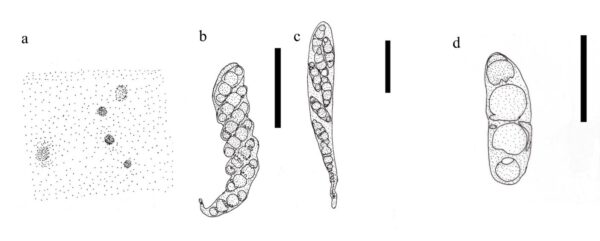Fungalpedia-Note 141 Aquihelicascus
Aquihelicascus W. Dong, H. Zhang & Doilom
Citation when using this entry: Shah et al. (in prep) – Fungalpedia, new genera in 2020. Mycosphere
Classification: Morosphaeriaceae, Pleosporales, Pleosporomycetidae, Dothideomycetes, Pezizomycotina, Ascomycota
Index Fungorum, Facesoffungi, freshwaterfungi.org, MycoBank, GenBank Fig 1.
Aquihelicascus was introduced by Hyde et al. (1998) to accommodate a new combination A. thalassioideus and two new species A. songkhlaensis and A. yunnanensis. The genus is saprobic on dead wood submerged in freshwater. The sexual morph is determined by submerged, grouped pseudostromata, visible on the host surface as ostiolar spots that might be uniloculate or multiloculate and have a flattened base. Ostioles are centered and globular and periphysate. Locules are compacted, subglobular to lenticular, or occasionally triangular, bear ostiolate papilla, and are submerged. Pseudoparaphyses are septate, hyaline, cellular, hypha-like structures that have been suspended in a gelatinous matrix. The peridium is a mass of angular cells with thin walls that are hyaline on the inside and dark on the exterior and fuse with the host cells. Aquihelicascus possess bitunicate, fissitunicate, club-shaped, elongate pedicels and asci with eight spores. Ascospores may overlap in a uniseriate or biseriate pattern or occasionally do so in a triseriate pattern. Ascopores have thin walls, are translucent, and smooth. They have a constriction at the septum and are unisepate, ellipsoidal, with a curved end. There is no report of an Aquihelicascus asexual morph. Aquihelicascus differs from Helicascus in having clavate asci with uncoiled endoascus, and biseriate, ellipsoidal, symmetrical, hyaline ascospores with rounded ends (Dong et al. 2020). Based on morphology and phylogenetic analysis of multiple genes (LSU, SSU, ITS and TEF), Aquihelicascus was characterized as a new genus in Morosphaeriaceae.
Type species: Aquihelicascus thalassioideus (K.D. Hyde & Aptroot) W. Dong & H. Zhang
Other accepted species:
Aquihelicascus songkhlaensis W. Dong, H. Zhang & K.D. Hyde 2020
Aquihelicascus yunnanensis W. Dong, H. Zhang & K.D. Hyde 2020
Figure 1 – Morphological characteristics of Aquihelicascus thalassioideus (redrawn from Dong et al. 2020). a Immsered fruting body, pseudostromata with ostiloes. b Ascus immersed in pseudoparaphyses. c, d Asci bitunicated. e Acospores. Scale bars: b-d = 50 μm, e = 20 μm
Figure 2 – Morphological characteristics of Aquihelicascus thalassioideus. (MFLU 18-1705). a, b Immersed pseudostromata with blackened ostiolar dots. c Ascus embedded in pseudoparaphyses. d, e Bitunicate asci. f, g Ascospores. Scale bars: c–e = 50 μm, f, g = 20 μm.
References
Hyde KD, Aptroot A. 1998 – Tropical freshwater species of the genera Massarina and Lophiostoma (ascomycetes). Nova Hedwigia 66, 489–502
Entry by
Sujit Shah, Center of Excellence in Fungal Research, Mae Fah Luang University, Chiang Rai 57100, Thailand.
Edited by Antonio R. Gomes de Farias & Kevin D. Hyde

